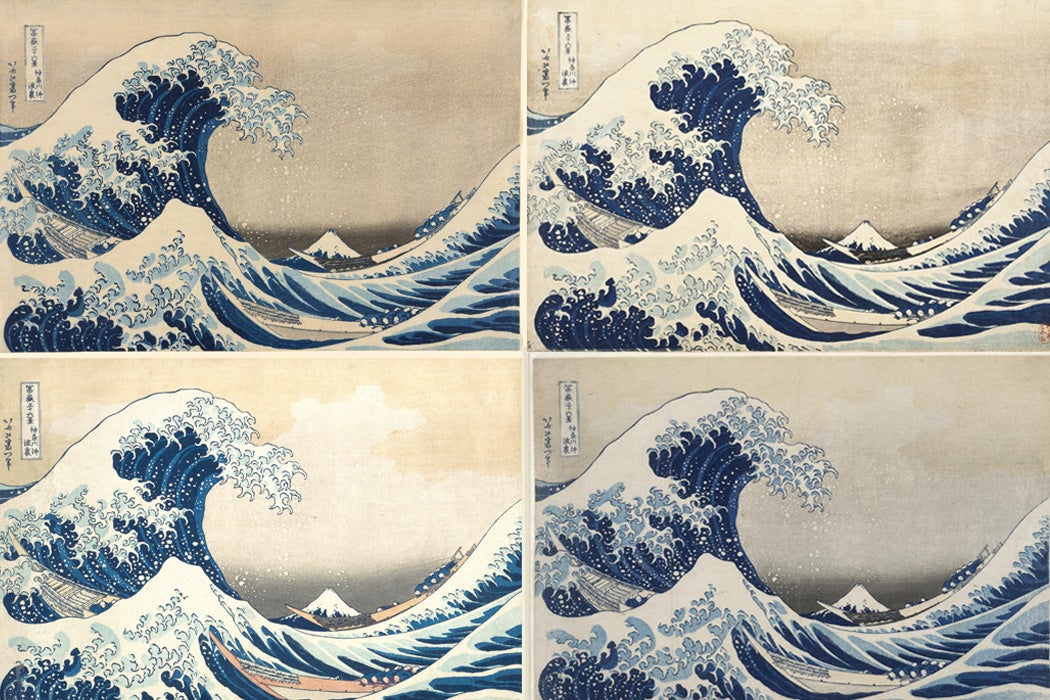Katushika Hokusai’s woodblock print “Great Wave off Kanagawa” is one of the world’s most recognizable images. A global icon, the thrilling print has been widely reproduced, repurposed, and, inevitably, parodied, including as the Cookie Monster.
According to scholar Timon Screech, the Great Wave is the only single work of Japanese art to have an entire English-language book devoted to it. In that monograph, Christina M. E. Guth argues that familiarity with the image “has contributed to the way many people visualize waves today.”
And, as Screech notes, the Great Wave took “a new lease on life, seemingly with a more profound resonance” after the disastrous Tohoku (or Great East Japan) earthquake and resulting tsunami in 2011. While Hokusai did not portray a tsunami, just seriously large breaking waves, his image had long been read as a visualization of the terrors of the sea, with the serene majesty of Mount Fuji—symbol of the nation—calmly positioned in the distance.
Screech points out that the print was originally part of a series called Thirty-six Views of Mt. Fuji, printed circa 1830–1833, but “now enjoys a largely independent existence, and perhaps it always did.”
Hokusai’s series was so popular, he and his publishers extended the sequence to forty-six views of Mt. Fuji, while keeping the original Thirty-six title. Individual prints in the series could be ordered on demand: the Great Wave was the most popular, with an estimated 5,000 copies of it made. Screech notes that this number was “very much more than other items in the set, and very high for Edo prints overall.”
Screech puts the print in context of Dutch maritime disaster paintings circulating in Japan. These were theologically tinged: one’s fate at sea rested in God’s hands. Hokusai had earlier made two other prints showing boats in heavy seas, without Mt. Fuji in the background. All three compositions clearly reveal “Western associations” and a “European flavor,” including European perspective. This, writes Screech, was not such much “a matter of ‘influence,’ but of cooption and adaptation,” similar to Japan’s approach in general to first European and then American culture and technology.
There’s also a commercial flavor: the boats depicted are high-speed, narrow, and unstable oshiokuribune, used to “deliver time-sensitive food to Edo’s markets.”
“The boats are bringing some seasonal first catch, and huge profits awaited those who could get samples to market soonest,” writes Screech. In fact, “the boats are probably the property of merchants who were risking human life on ferocious seas for vast financial rewards.”
The print’s Japanese caption is translated as “Under the Waves off Kanagawa.” Screech suggests an alternate title: “Ships in distress.” The threat of the sea is real, the crews—you have to look closely to see them—in danger. Hokusai skillfully caught the action in the middle of things, with the viewer left wondering what happens next. But there in the distance is the great snow-crowned volcano, whose name puns as fu ji, “no death.” The mountain is, writes Screech, “a location of salvation” amid the tumultuous sea.
Weekly Newsletter
The Great Wave is also an astonishing composition of blue and white. Before 1830, when Hokusai started his Views project, Japanese artists were bereft of a good, bright, permanent blue to blue with. But then, starting in 1830, Berlin blue (a.k.a. Prussian blue, the first modern synthetic pigment) came to Japan in sufficient qualities to be used in popular works. That is, it was suddenly cheap enough for printmaking.
Called bero in Japanese, after Berlin, this blue’s introduction was a “radical event in the history of Japanese prints.” Hokusai was on the forefront of this, saturating prints with blue skies and stormy blue seas. You can compare how the colors have survived amongst seven versions of the Great Wave at the Museum of Fine Arts, Boston. And, courtesy of the Metropolitan Museum of Art, learn how the printers used the new bero with the old indigo.
Support JSTOR Daily! Join our membership program on Patreon today.







